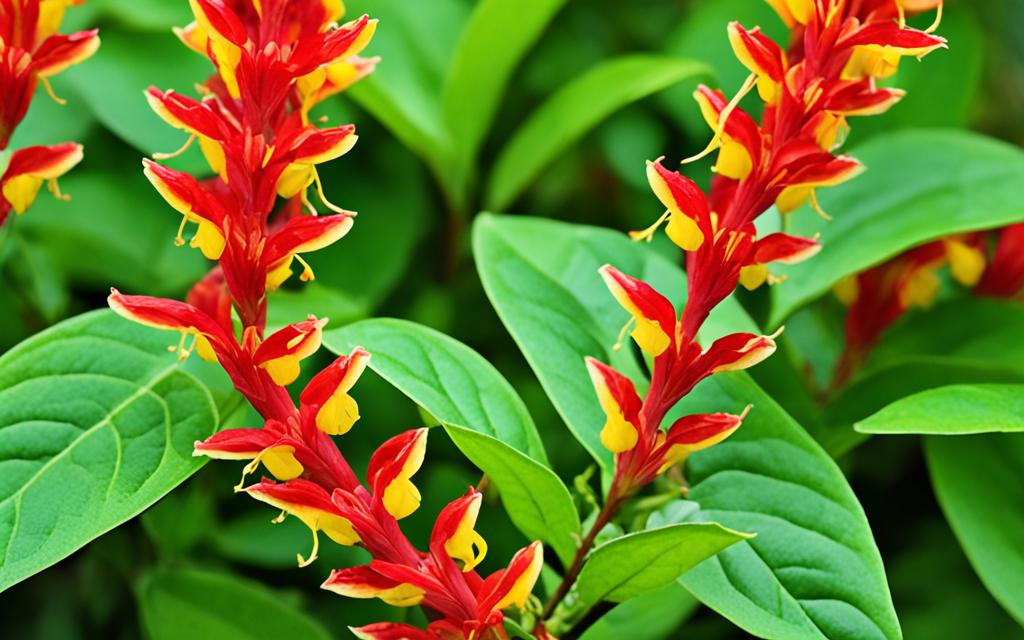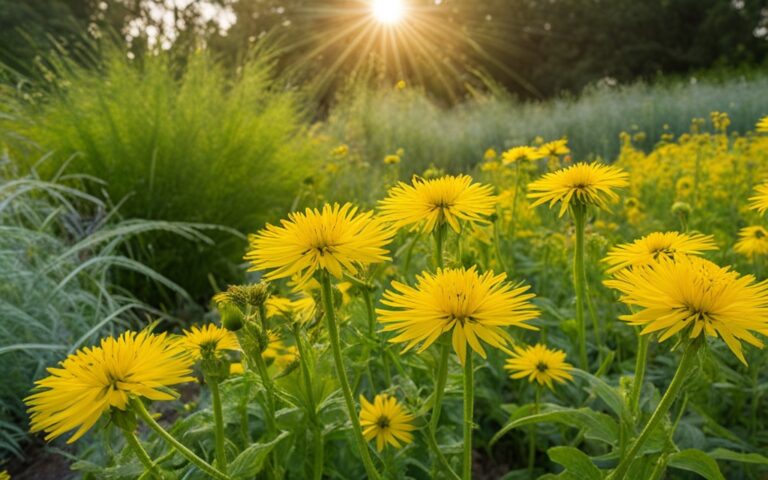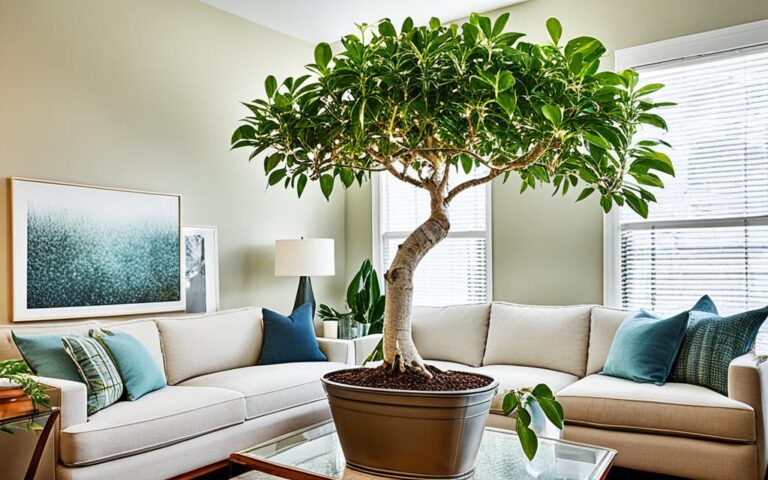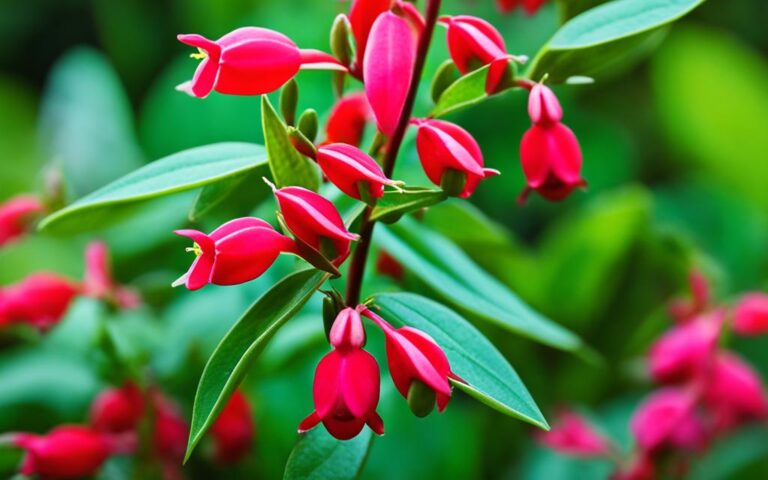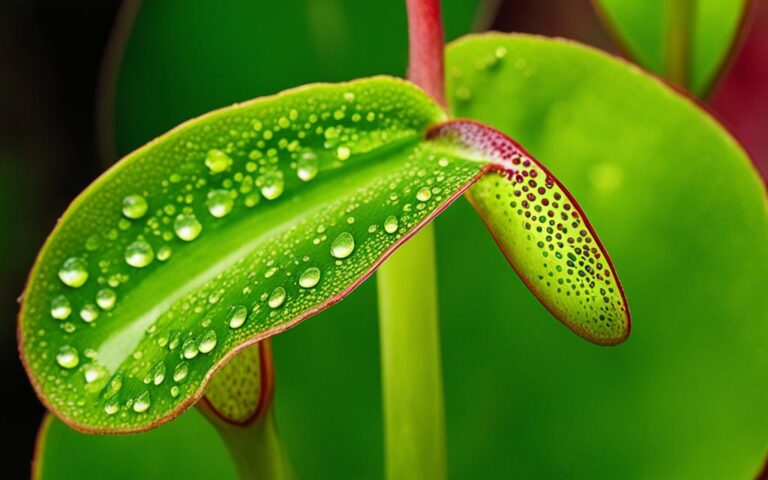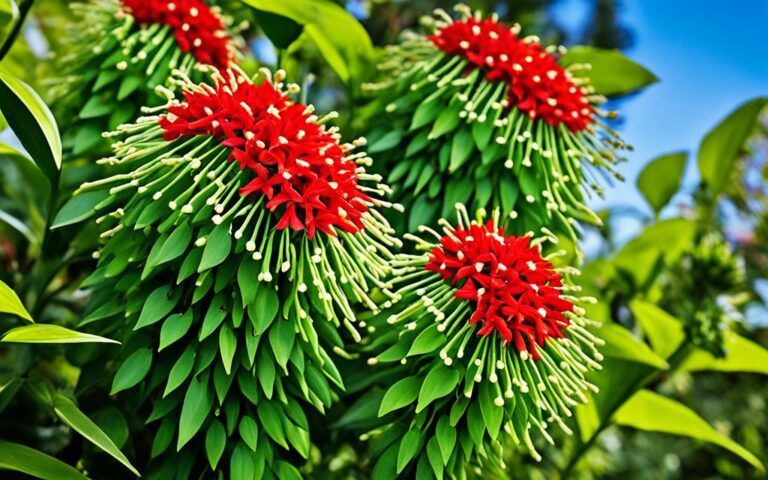Shrimp Plant: Vibrant Tropical Blooms for Your Garden
Did you know the golden shrimp plant, or Justicia brandegeana, can reach up to 6 feet tall in warm areas? This tropical shrub comes from Mexico, Guatemala, and Honduras. It’s loved for its unique shrimp-like flowers in bright red, pink, and yellow. These flowers, up to 2 inches long, make any outdoor space feel like the tropics.
This evergreen perennial loves warm, tropical climates. Gardeners use it as a landscape plant, hedge, or border in zones 9-11. It’s easy to care for, making it a favorite for adding a touch of the exotic to gardens.
Key Takeaways
- The shrimp plant, or Justicia brandegeana, is a tropical shrub with unique shrimp-like blooms in red, pink, and yellow shades.
- It can grow up to 6 feet tall in warm climates and is commonly used as a landscape plant, hedge, or border in tropical and subtropical regions.
- The shrimp plant is an evergreen perennial that requires minimal care, making it a popular choice among gardeners.
- It is native to regions of Mexico, Guatemala, and Honduras and thrives in USDA Hardiness Zones 9-11.
- The shrimp plant’s vibrant blooms and deep green foliage add a captivating touch of the tropics to any outdoor space.
Introduction to the Shrimp Plant
The shrimp plant, also known as the Mexican shrimp plant, is a vibrant and captivating plant. It belongs to the Acanthaceae family and is native to Central America’s tropical regions. This evergreen perennial has become a favorite in gardens and landscapes around the world.
Its shrimp-like, colorful bracts and constant blooming make it a popular choice. Gardeners love it for its beauty and easy care.
Importance and Popularity
Shrimp plants are easy to care for, making them great for both new and experienced gardeners. They bloom all year, even in warm climates, which has made them more popular. They come from countries like Mexico, Guatemala, and Honduras.
Now, they also thrive in places like Florida, where the tropical weather suits them well.
Interesting Facts
- The unique name “shrimp plant” comes from the shrimp-like appearance of the vibrant bracts that surround the small white flowers.
- Shrimp plants can grow up to 3-4 feet tall and wide, creating a lush and eye-catching presence in any garden.
- The plant is known for its ability to bloom constantly, with some varieties producing flowers for 9-10 months out of the year, especially in Southern California.
- Shrimp plants are described as becoming thin and sparse if not pruned, with leaves turning yellow and then black before falling off in cooler weather.
- The plant’s stamens and the 3-lobed lower lip of its flowers are designed to resemble a shrimp’s stalked eyes and folded around tail, respectively.
The shrimp plant has won over gardeners worldwide with its vibrant, shrimp-like blooms. It’s loved for its easy care, constant flowering, and ability to thrive in warm climates. This makes it a top choice for both indoor and outdoor gardens.
Common Species and Varieties
The shrimp plant family has many vibrant species, each with its own charm. The red-bracted shrimp plant, yellow-bracted shrimp plant, and variegated shrimp plant are among the favorites.
Red-bracted Shrimp Plant
The red-bracted shrimp plant, known as Justicia brandegeana, is well-known. It has bright red bracts that look like shrimp and small white flowers in the center. This plant can grow up to 3-4 feet tall and loves warm, tropical places.
Yellow-bracted Shrimp Plant
The yellow-bracted shrimp plant, also known as the “Yellow Queen,” looks similar to the red one. But it has vibrant yellow bracts instead. It can grow up to 6 feet tall and 8 feet wide, making a great hedge. Its leaves are dark green, shiny, and have deep veins.
Variegated Shrimp Plant
The variegated shrimp plant is a standout in the Justicia family. It has shrimp-shaped bracts and leaves with a mix of green and white variegation. The white flowers that come out add to its beauty.
Anatomy and Characteristics
Description of Leaves, Stems, and Flowers
The shrimp plant, known as Justicia brandegeana, has beautiful, dark green shrimp plant leaves that can reach up to 6 inches long. These leaves are opposite and lance-shaped, creating a stunning contrast with the bright flower spikes. The stems are woody and branch out, covered with these dark green leaves.
The shrimp plant flowers are the real showstoppers. They have bright yellow, pink, or red bracts that look like shrimp, hence the name. These bracts surround small, white flowers with two lips that stick out a bit.
Special Features
The shrimp plant is known for its bracts that look like shrimp, adding a tropical touch. These bracts come in red, yellow, or mixed colors. The plant stays green all year in warm places, making it a favorite for gardeners looking for shrimp plant special features.
“The shrimp plant’s vibrant bracts and evergreen nature make it a standout addition to any tropical garden.”
Ideal Growing Conditions
Shrimp plants, also known as Justicia brandegeeana, love specific conditions to show off their bright tropical colors. It’s key to know their light, temperature, humidity, soil, and watering needs to grow these plants well.
Light Requirements
Shrimp plants do well in full sun to partial shade, but they shine best with morning sun. They need sunlight to get their striking colors. So, a spot with bright, indirect light is perfect, especially indoors. But, don’t put them in intense midday sun as it can fade their leaves and flowers.
Temperature and Humidity Needs
Being tropical, shrimp plants love warm weather with temps above 55°F (13°C). They grow best in a temperature range of 65 to 75°F (18 to 24°C). These plants hate frost and freezing, so protect them in cold areas. They also like high humidity and should be misted often or kept near a humidifier to feel at home.
Soil and pH Preferences
Shrimp plants prefer soil that drains well and is loamy to avoid waterlogging and root rot. They do best in soil with a pH of 6.0 to 7.0. A nutrient-rich, organic soil that drains well is perfect for them.
Watering Needs
Shrimp plants like their soil to be consistently moist but not soaked. Wait until the top inch of soil feels dry before watering again. In warmer months, they might need watering 1-2 times a week. In winter, you can water less. Proper watering is key to keeping them healthy and strong.
| Growing Condition | Ideal Range |
|---|---|
| Light | Partial sun to bright, indirect light |
| Temperature | 65 to 75°F (18 to 24°C) |
| Humidity | High humidity, regular misting |
| Soil | Well-draining, loamy, slightly acidic to neutral (pH 6.0-7.0) |
| Watering | Consistently moist, allow top inch to dry before watering again |
By giving shrimp plants the best growing conditions, gardeners can enjoy their vibrant tropical blooms for months.
Propagation Methods
Shrimp plants are a favorite in many gardens for their bright colors and elegant leaves. You can easily grow more of these tropical plants by propagating them. The best way to do this is by taking cuttings in the spring, when they start growing more.
To start, cut a 4- to 6-inch stem just below a leaf node, making sure it has at least three leaves. Then, dip the cut end in rooting hormone to help roots grow faster. Plant the cutting in a potting mix that drains well. Keep the cutting in a humid spot until it develops roots, which can take weeks or months.
For a quicker way to grow more shrimp plants, try dividing an existing one in early spring. Start by lifting the plant from the soil and separating it into smaller sections. Make sure each section has healthy roots. Then, replant these sections in soil that drains well and water them well.
Shrimp plants can also be grown from seeds, but this is slower and less reliable than cutting or dividing. If you want to try seeds, plant them in a mix made for starting seeds. Keep the soil moist until the seeds sprout.
No matter how you choose to propagate your shrimp plants, make sure they have the right conditions to grow. Keep the temperature between 65-75°F, the soil moist but not too wet, and give them bright, indirect light. With care, you can multiply your shrimp plants and enjoy their beautiful flowers in your garden.
Remember, growing shrimp plants takes time. It might be weeks or months before roots form. But with the right care and conditions, you’ll soon have new plants to enjoy for years.
Care and Maintenance
Keeping your shrimp plant (Justicia brandegeana) healthy is key. This includes pruning, training, managing pests and diseases, and using the right fertilizer. Follow these steps to help your shrimp plant thrive.
Pruning and Training Techniques
Prune your shrimp plant when it starts to slow down in winter and early spring. Cut off dead branches, spent flowers, and too much foliage. This keeps the plant neat and encourages more growth and flowers. Regular pruning helps keep the plant looking great and full.
Pest and Disease Management
Shrimp plants are usually pest-free but can get aphids, mealybugs, scales, spider mites, and whiteflies. Check the plant often and treat with insecticidal soap or neem oil if you find pests. If you see fungal spots on the leaves, cut off the affected parts and make sure air moves well around the plant.
Fertilizer Requirements
Feed your shrimp plant a balanced fertilizer in spring and summer. Use it every four to six weeks to help it grow and bloom well. But don’t overdo it with the fertilizer, as it can harm the plant.
Shrimp Plant Benefits
The shrimp plant is a beautiful addition to any garden. It offers many benefits that make it a favorite among gardeners. Its evergreen nature means it stays colorful all year, adding tropical flair to your garden.
This plant is easy to care for, perfect for busy gardeners. It loves warm, humid places and can handle dry spells. So, you don’t have to spend a lot of time on it.
The shrimp plant is great for the environment too. Its bright flowers draw in bees, butterflies, and hummingbirds, helping with pollination. It also makes oxygen, improving the air around you.
It’s not just good for the planet. The shrimp plant can be eaten and adds unique flavors to food. This makes it a tasty and healthy choice for your kitchen.
This plant is also full of symbolism and can decorate any space. In some cultures, its many flowers mean good luck. In Feng Shui, it’s thought to bring balance and positivity.
Whether you’re new to gardening or have been doing it for years, the shrimp plant is a great choice. It’s easy to care for, helps the environment, is good for your health, and looks great in any decor.
Planting a Shrimp Plant
Best Time to Plant
The best time to plant a shrimp plant is in early spring. This lets the plant get its roots set and adjust to its new spot before the warm season. Make sure to plant them at least 3 feet apart to let them grow fully.
Site Selection and Preparation
Shrimp plants do best in bright, morning sun. They can handle some shade but need at least 6 hours of direct sunlight daily. The soil should be well-draining and have a slightly acidic to neutral pH. Make sure the soil is ready with the right drainage and nutrients before moving the shrimp plant.
The shrimp plant (Justicia brandegeana) grows 3 to 4 feet tall and spreads out just as wide. They are from Mexico and are often seen in the wild there. They are perennials and part of the Acanthaceae family. Shrimp plants are hardy in zones 10-11 and bloom all year if the conditions are right.
When getting the site ready for planting, space shrimp plants 2 to 3 feet apart for best growth. The soil should be a bit acidic to neutral, with good drainage to avoid waterlogging. Adding organic matter to the soil can help with drainage and nutrients.
Choosing the right spot and preparing the soil well will help your shrimp plant flourish. This way, you’ll get beautiful, tropical flowers in your garden.
Protecting from Frost and Cold
Shrimp plants add a pop of color to any garden. But, they don’t like frost or cold too much. These plants need protection to stay healthy and keep blooming.
Bringing your shrimp plant inside when it gets cold is the best way to keep it safe. Move it into a pot and put it in a sunny window or a bright room. This keeps the plant away from the cold outside.
If you can’t bring the plant inside, cover it with a garden blanket or something similar. This keeps the frost away and protects the leaves and flowers. Just remember to take off the cover during the day so the plant gets sunlight.
| Temperature Range | Percentage of Plants Able to Withstand |
|---|---|
| 28 to 23 degrees or below | 55% |
| 23 to 15 degrees or below | 32% |
| 32 to 28 degrees or below | 13% |
Shrimp plants do best in temperatures between 65°F to 75°F (18°C to 24°C). They also like a humidity level of about 50%. Keeping the temperature steady is key to their health. Changes in temperature can cause problems like curled leaves, wilting, and browning.
By protecting your shrimp plant from frost and cold, you can make sure it thrives. This way, you can enjoy its beautiful flowers for many years.
Encouraging Blooms
Shrimp plants are famous for their bright, tropical flowers. These flowers can make any garden or indoor area look lively. To get more of these beautiful flowers, follow a few important tips.
First, make sure the soil around your shrimp plant stays moist but not too wet. If the soil gets too dry, it can stop the plant from blooming. Water your plant often to keep the soil damp but not soaked.
- Perform light pruning to stimulate new growth and encourage more blooms.
- Keep your shrimp plant in a location with bright, indirect sunlight. Adequate light exposure is crucial for robust flowering.
- Reduce the nitrogen content in your fertilizer and opt for a product with a higher phosphorus ratio. This nutrient balance can help promote stronger blooming.
By following these simple tips, you can help ensure your shrimp plant gives you lots of those vibrant, eye-catching blooms. These blooms make the plant a favorite in any garden or indoor space.
“Shrimp plants are a true delight, with their stunning flowers that seem to dance in the breeze. Encouraging their blooms is a rewarding challenge for any gardener.”
Common Problems and Solutions
Keeping your shrimp plant looking great can be a bit tricky. You might face issues like yellow leaves, droopy leaves, or leggy stems. Knowing how to fix these problems is crucial for your plant’s health. Let’s look at some common issues and how to solve them.
Yellowing Leaves
Yellow leaves on your shrimp plant usually mean it’s not getting enough light or it’s getting too much water. First, make sure it’s in a spot with bright, indirect light. If it’s in a pot, try moving it closer to the window. Also, check how often you’re watering it and let the soil dry out a bit between waterings. Giving it a balanced fertilizer can also help with nutrient issues.
Drooping Leaves
Leaves that droop often need more water. Make sure to water your plant well, so the soil is damp but not too wet. Keep watering consistent, especially when it’s hot. If the problem doesn’t go away, the plant might be root-bound and needs a bigger pot.
Leggy Growth
A shrimp plant that’s tall and thin usually lacks enough light. Move it to a brighter spot, either in direct sunlight or under bright indirect light. Cutting back the long stems can also make the plant fuller and more compact.
Fungal Issues
Seeing spots or patches on your shrimp plant’s leaves could mean a fungal disease. Cut off any bad leaves, make sure air moves well around the plant, and use a fungicide spray to stop the disease from spreading.
By quickly fixing these common problems, you can keep your shrimp plant healthy and beautiful.
Conclusion
The shrimp plant is a bright, tropical addition to any garden or indoor spot. It has unique shrimp-like flowers and evergreen leaves. It’s also easy to care for, making it a favorite among gardeners.
By giving it plenty of sunlight, consistent moisture, and protection from frost, you can enjoy its beautiful flowers all year. This plant is versatile and can thrive in many settings, adding tropical vibes to your space.
It’s great for both experienced and new gardeners. The shrimp plant adds color, texture, and interest to your garden or home. As you start with the shrimp plant, think about its specific needs and the different types out there.
With the right care, this vibrant tropical plant can be a lovely centerpiece in your garden or indoor area. It will surely delight both you and your guests.
